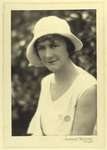Susan Glaspell, Pioneering Playwright of
Midwestern Roots and Modernist Invention
Susan Glaspell (1876-1948), Pulitzer-winning playwright, best-selling novelist, and co-founder of one of America’s most influential theatre companies, was born in Davenport, Iowa in 1876. Resisting more conventional roles for women of her generation, Glaspell graduated from Drake University and went to work as a reporter for the Des Moines Register. In 1900, she covered the murder trial that inspired her best-known play, Trifles, which she later revised as the popular short story, A Jury of Her Peers. A year later, Glaspell left journalism to write short fiction, quickly becoming a frequent contributor to popular and literary magazines. As she wrote about the life she knew as a middle-class Midwestern woman, Glaspell broadened her view of the world with membership in discussion groups devoted to the era's newest ideas: socialism, anarchism, Freudian psychology, and feminism. She also traveled to Chicago, New York, and Europe, finally settling in Greenwich Village.
In the Village, Glaspell joined two feminist organizations: Heterodoxy and the Lucy Stone League, and, in 1914, declared in print her allegiance to socialism and suffrage. She published three novels between 1909 and 1915, all dealing with contemporary themes of changing sexual and social relations. At the age of thirty-seven, Glaspell married the twice-divorced, charismatic socialist and former classics professor, George Cram “Jig” Cook. In 1915, they became co-founders of the Provincetown Players, an experimental theatre company dedicated to American playwrights of serious social and artistic purpose. For the eight years of its existence, Glaspell contributed eleven plays to this group (two co-authored with Cook) that were innovative in form and provocative in content. Glaspell's Trifles and Bernice introduced the device of the unseen protagonist; The Verge combined expressionist visualization with radical experiments in language; The Outside and Bernice combined naturalism with symbolist or surreal undercurrents. In 1920 Glaspell’s Inheritors questioned whether “fighting for democracy abroad” was a reason “not to have any at home?”
After the dissolution of the Provincetown Players and Cook’s sudden death in 1924, Glaspell returned to drama briefly but significantly in the 1930s, winning a Pulitzer prize for Alison’s House, inspired by the life of Emily Dickinson, and serving as Director of the Midwest Playwrights Bureau of the Federal Theatre Project. Meanwhile she had published a genre-blurring biography of Cook and three best-selling novels, Brook Evans (1928), Fugitive’s Return (1929), and Ambrose Holt and Family (1930).
After resigning from the Federal Theatre Project in 1938, Glaspell returned to Provincetown, completing three novels drawing on her Midwestern roots: The Morning is Near Us, Norma Ashe, and Judd Rankin’s Daughter. She died in Provincetown in 1948.
Although Glaspell's reputation waned shortly after her death, interest in Glaspell has soared in recent years. The remarkable increase in Glaspell scholarship during the past decade, along with the formation of the Susan Glaspell Society in 2003, suggest that this pioneering playwright will be long remembered.
-- Cheryl Black
Sources and further reading:
Ben-Zvi, Linda. Susan Glaspell: Her Life and Times. London: Oxford University Press, 2005.
Ben-Zvi, Linda and J. Ellen Gainor. Susan Glaspell: The Complete Plays.
Jefferson, NC: McFarland, 2010.
Bigsby, C.W.E., ed. Plays by Susan Glaspell. New York and London: Cambridge University Press, 2006.
Carpentier, Martha C. The Major Novels of Susan Glaspell. Gainesville: University Press of Florida, 2001.
Gainor, J. Ellen. Susan Glaspell in Context. Ann Arbor: University of Michigan Press, 2001.
Ozieblo, Barbara. Susan Glaspell: A Critical Biography. Chapel Hill: University of North Carolina Press, 2000.
Susan Glaspell Society website. academic.shu.edu/glaspell/.
*Image courtesy of NYPL website.




